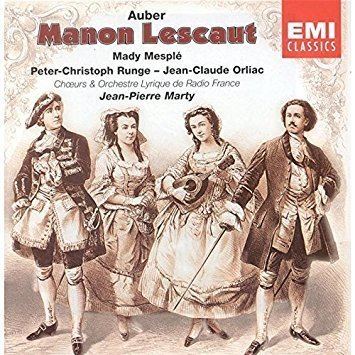First performance 23 February 1856 | Language French | |
 | ||
Similar Haydée, Le domino noir, Fra Diavolo, L'ambassadrice, La circassienne | ||
Manon Lescaut is an opera or opéra comique in 3 acts by Daniel-François-Esprit Auber to a libretto by Eugène Scribe, and, like Puccini's Manon Lescaut and Massenet's Manon, is based on the Abbé Prévost's novel Manon Lescaut. Auber's version is nowadays the least-performed of the three.
Contents
Performance history
The opera was premiered on 23 February 1856 by the Opéra-Comique at the second Salle Favart in Paris. It was the first work to be staged by that company that did not have a happy ending. It was staged in Liege in 1875, revived at the Opéra-Comique in 1882, and regularly performed in Germany as well as France. However, since the dawn of the twentieth century stagings have become something of a rarity.
In North America, the opera was performed in 2006 by the Lyric Opera of Los Angeles at the Los Angeles Theatre.
In 1990, it was staged at the Opéra Comique de Paris with the Picardy Sinfonietta in Amiens conducted by Patrick Fournillier. Next year the live recording of the opera was released by the French label Le Chant du Monde. Another stage performance took place at the Wexford Festival in October/November, 2002.
Synopsis
The story only loosely resembles the original novel by Prévost (where, for instance, Lescaut is Manon's brother, not her cousin). There is one character - the Marquis d'Herigny - who represents the several wealthy suitors that Manon became involved with in the novel. Some other characters are absent entirely, and others are completely new to this telling of the story.
Music
The role of Manon Lescaut is a demanding one, with a very high tessitura, extended florid passages and arias of outstanding technical difficulty. Nonetheless, it also presents great opportunities for characterisation and (at least before the appearance of the operas on the same subject by Puccini and Massenet) was one of the staples of the operatic repertoire - not only in France, but also in Germany. The role of the Marquis d'Herigny, written for the famous baritone, Jean-Baptiste Faure, also features several significant solos; but the tenor role of Des Grieux (given two major arias by Massenet and three by Puccini) lacks a major solo, although the character does participate in a series of fine duets, notably at the death of Manon near the end of the opera.
One number in the score has retained its popularity with coloratura sopranos. This is Manon's solo, "C'est l'histoire amoureuse", also known as "L'éclat de rire" or the Laughing Song. It is not a free-standing aria - in fact, it forms part of the Act 1 finale - but ever since its creation it has been a chosen showcase for the technique of singers such as Adelina Patti (who sang it during the lesson scene in The Barber of Seville), Amelita Galli-Curci, Joan Sutherland and Edita Gruberová.
